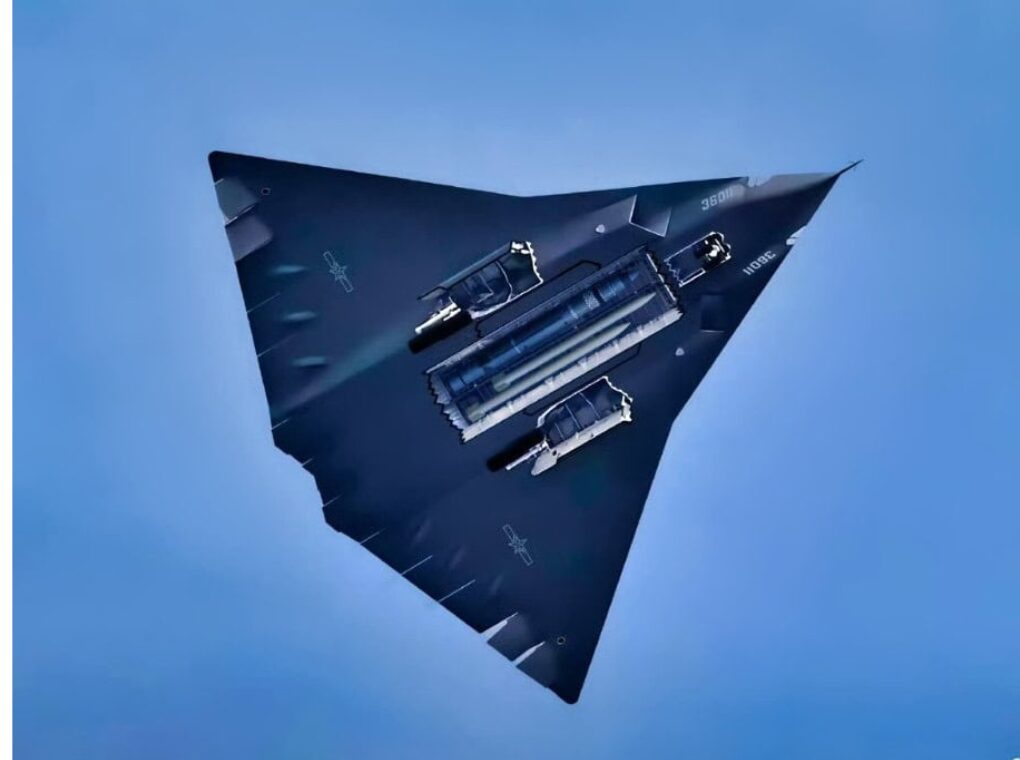A mysterious, tailless stealth aircraft — now widely referred to as the J-36 — was spotted over China’s Chengdu city late last year. Drawing comparisons to the iconic US B-2 Spirit bomber, the aircraft has triggered a wave of speculation among defence watchers. But as excitement builds, many are asking a sobering question: Will the J-36 succeed where many of China’s high-profile weapons systems have failed?
A Flying Wing Appears Over Chengdu
In late 2024, grainy footage of a futuristic aircraft resembling a flying wing appeared on Chinese social media. Analysts quickly linked the aircraft to the Chengdu Aircraft Corporation, which also manufactures the J-20 stealth fighter and JF-17, a low-cost export fighter co-developed with Pakistan.
The aircraft’s silhouette, cockpit layout, and size suggest a stealthy, long-range bomber or multi-role combat platform. Several outlets — including Janes, The Aviationist, and South China Morning Post — have identified it as the “J-36”, based on markings on the prototype.
Design elements such as a tailless delta-wing layout, a possible tri-engine configuration, advanced stealth features, and an unusually large airframe have sparked comparisons with America’s B-2 and the YF-23 prototypes. However, some experts urge caution, noting that much of the imagery is unverified, and China has a long history of overpromising and underdelivering in military hardware.
A Pattern of Underwhelming Performance
Despite China’s dramatic rise in global defence manufacturing, its military hardware — especially high-tech systems — has often suffered from poor battlefield performance, quality issues, or unproven capabilities.
Notable examples include:
JF-17 Thunder: Co-developed by China and Pakistan, this fighter has been fielded in combat against India during Operation Sindoor. Reports from that conflict suggest poor targeting systems, limited range, and reliability issues, casting doubt on the fighter’s viability in high-intensity warfare.
Type 99 Tank: Once hyped as China’s answer to Western main battle tanks, the Type 99 has not been combat-proven. Reports from Chinese exercises and simulations suggest it struggles in rugged terrain, extreme temperatures, and has inferior fire control systems compared to NATO counterparts.
HQ-9 Air Defence System: Often dubbed China’s version of the Russian S-300, the HQ-9 has reportedly underperformed in real-world drills, especially in electronic warfare scenarios, raising concerns about its viability in contested airspaces.
Naval Platforms: China’s early-generation warships, including the Type 052 destroyers, were plagued with mechanical failures, radar weaknesses, and low survivability ratings. While newer vessels are more advanced, their performance remains largely untested in real conflict.
UAVs and Drones: Despite flooding the market with cheap drones like the Wing Loong II, China’s UAVs have seen lacklustre performance in Middle Eastern battlefields, especially when compared to US or Turkish systems like the Bayraktar TB2.
J-36: Real Game-Changer or Another Showpiece?
The J-36’s reported features — including petal-style exhausts, advanced intake designs, internal weapons bays, and long-range mission profiles — would mark a serious step forward in Chinese stealth and strike capability if proven functional.
But experts caution that China’s military-industrial complex often produces visually impressive prototypes that lack combat-tested reliability. Many suspect that the J-36, like the J-20 before it, may suffer from engine performance issues, software glitches, or logistical complications in real-world deployments.
Even the aircraft’s alleged use of three modified WS-10C engines raises eyebrows. China’s long-standing struggle to develop reliable jet engines — with decades of dependence on Russian designs — is a well-known Achilles’ heel in its air power development.
A Hype Cycle or Strategic Breakthrough?
The J-36, nicknamed the “Gingko leaf” for its shape, is believed to be a testbed for future long-range bombing and drone-command operations. With a wingspan possibly double that of the J-20, it could carry heavier payloads and integrate future technologies like AI-based combat control or hypersonic missile compatibility.
But until the aircraft is deployed, tested, and proven under duress, many in the defence community remain skeptical.
“China has built eye-catching platforms before — but war isn’t won in airshows,” said a senior defence analyst. “We’ll believe in the J-36 when it survives a modern air defence network, not before.”
While the J-36 signals China’s ambitions to rival US air dominance, its success depends on moving beyond flashy prototypes and delivering combat-proven capability — something that many of China’s weapons have failed to achieve.
